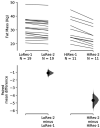Effects of Four Lipid Metabolism-Related Polymorphisms on Body Composition Improvements After 12 Weeks of High-Intensity Interval Training and Dietary Energy Restriction in Overweight/Obese Adult Women: A Pilot Study
- PMID: 34539437
- PMCID: PMC8440869
- DOI: 10.3389/fphys.2021.712787
Effects of Four Lipid Metabolism-Related Polymorphisms on Body Composition Improvements After 12 Weeks of High-Intensity Interval Training and Dietary Energy Restriction in Overweight/Obese Adult Women: A Pilot Study
Abstract
Background: Polymorphisms in lipid metabolism-related genes have been associated with obesity and body composition, but these have been scarcely described concerning the magnitude of the response to exercise interventions in the overweight/obese population. Objective: To evaluate the association of perilipin 1 (PLIN1; rs1052700 and rs2304795), lipoprotein lipase (rs283), and adrenoceptor beta 3 (rs4994) polymorphisms with high and low responders (LoRes) to fat mass reduction after 12 weeks of high-intensity interval training (HIIT) and dietary energy restriction in overweight/obese adult women. In addition, we examined the effect of these genetic variants on body composition changes. Methods: Forty-three unrelated overweight/obese adult women were incorporated and genotyped, of which 30 women (age = 27.4 ± 7.9 years; BMI = 29.9 ± 3.3 kg/m2) successfully completed the 12-week supervised HIIT program plus an individually prescribed home hypocaloric diet. Results: An association was observed between the PLIN1 rs1052700 polymorphism with high and LoRes (χ 2 = 8.138; 2 df; p = 0.01). Moreover, after the intervention, the carriers of TT genotype of PLIN1 rs1052700 as compared to AA and AT showed a greater reduction in absolute fat mass (Δ: -5.1 ± 1.8 vs. - 1.8 ± 1.4 vs. - 2.1 ± 2.3 kg; p = 0.04). The effect size of this fat mass reduction between TT and AT genotypes was a mean difference of -3.01 kg [95%IC - 4.88- - 1.1], and between TT and AA genotypes was -3.29 kg [95%IC - 4.86- - 1.65]. No differences were observed for other polymorphisms investigated. Conclusion: These results suggest that the rs1052700 (14995A>T) polymorphism of the PLIN1 gene is associated with a differential response to fat mass reduction after a 12-week intervention in overweight/obese adult women. In addition, women with the TT genotype of this genetic variant showed greater changes in fat mass than AA and AT genotypes. However, further studies are needed to confirm these findings.
Keywords: exercise; genetic polymorphisms; high-intensity interval training; inter-individual variability; obesity; women.
Copyright © 2021 Andrade-Mayorga, Díaz and Salazar.
Conflict of interest statement
The authors declare that the research was conducted in the absence of any commercial or financial relationships that could be construed as a potential conflict of interest.
Figures



References
-
- Álvarez C., Ramírez-Campillo R., Cristi-Montero C., Ramírez-Vélez R., Izquierdo M. (2018). Prevalence of Non-responders for Blood Pressure and Cardiometabolic Risk Factors Among Prehypertensive Women After Long-Term High-Intensity Interval Training. Front. Physiol. 9:1443. 10.3389/fphys.2018.01443, PMID: - DOI - PMC - PubMed
-
- Alvarez C., Ramirez-Campillo R., Ramirez-Velez R., Izquierdo M. (2017). Prevalence of non-responders for glucose control markers after 10 weeks of high-intensity interval training in adult women with higher and lower insulin resistance. Front. Physiol. 8:479. 10.3389/fphys.2017.00479, PMID: - DOI - PMC - PubMed
LinkOut - more resources
Full Text Sources
Miscellaneous

